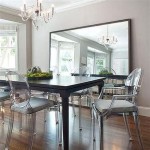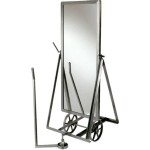How To Tell If A Mirror Is One-Sided
The concept of a "one-way mirror" is often portrayed in movies and television shows, typically in interrogation rooms or surveillance scenarios. These mirrors appear reflective on one side but transparent on the other, allowing individuals to observe others without being seen. However, discerning a true one-way mirror from a standard mirror requires careful observation and testing. This article outlines several methods to help determine if a mirror is indeed one-sided.
The Fingernail Test
One commonly cited method is the fingernail test. This involves placing one's fingernail directly against the surface of the mirror. With a standard, two-way mirror, a noticeable gap exists between the fingernail's reflection and the fingernail itself. This is due to the glass layer present in front of the reflective backing. Conversely, with a one-way mirror, the fingernail and its reflection appear to touch directly, with minimal to no gap. This suggests the reflective layer is on the front surface of the glass, a characteristic of one-way mirrors.
The Lighting Conditions Test
The lighting conditions in the two rooms separated by the mirror play a crucial role in its functionality. One-way mirrors rely on a significant difference in light levels between these two areas. The observation room (behind the mirror) must be significantly darker than the room being observed. This allows observers to see through the partially reflective surface. If lighting levels are similar on both sides, the mirror will function as a standard two-way mirror, reflecting images on both sides.
Observing the Surrounding Environment
Careful observation of the surrounding environment can provide further clues. If a room seems unusually dark despite the presence of apparent light sources, it might indicate the presence of a one-way mirror. This darker room could be the observation area, kept dim to maintain the functionality of the mirror. Look for signs of cameras or other surveillance equipment, which often accompany one-way mirrors.
The Sound Test
Sound transmission can be another indicator. One-way mirrors designed for observation are often part of a larger system, including potentially concealed speakers and microphones for communication. Try tapping lightly on the mirror's surface and listening carefully for any hollow sounds or unusual reverberations. This could suggest the presence of a cavity or hidden equipment behind the mirror.
Peeking Around the Edges
Attempting to peek around the edges of the mirror can reveal clues about its construction. If there's a noticeable frame or casing, try to see if there are any gaps or seams that might suggest a concealed observation area behind the mirror. This might require careful examination and potentially the use of a small flashlight to peer into any crevices.
The Brightness Comparison Test
Comparing the relative brightness of the reflected image compared to the surrounding environment can be informative. In a brightly lit room, a standard two-way mirror will produce a reflection of similar brightness. However, a one-way mirror will appear slightly dimmer due to the partial reflectivity of the surface, allowing some light to pass through to the observation area. This slight dimming of the reflected image can be a subtle but significant indicator.
Using a Flashlight
Shining a bright flashlight against the surface of the mirror can help determine the reflectivity of the surface. With a standard mirror, the light will be largely reflected back. With a one-way mirror, some of the light will pass through, potentially illuminating the observation room behind. This is especially helpful if the observation room is darkened, making the transmitted light more noticeable.
Considering the Context
The location and context of the mirror should be carefully considered. One-way mirrors are typically used in specific settings, such as police interrogation rooms, security checkpoints, or research facilities. Finding a mirror in a residential setting or a public restroom, for example, makes it far less likely that it would be a one-way mirror. Always consider the environment and the probability of such a mirror's presence.
Seeking Professional Assistance
If there are strong suspicions regarding the nature of a mirror, seeking professional assistance is recommended. Law enforcement or security professionals can conduct a thorough examination and determine with certainty if the mirror is indeed a one-way mirror. They have the expertise and specialized equipment to assess the situation accurately and provide definitive answers, ensuring peace of mind and addressing any potential privacy concerns.

How To Tell If A Mirror Is Two Way Or Not 8 Steps With Pictures

How To Tell If A Mirror Is One Way Glass Boing

How To Tell If A Mirror Is Two Way Or Not 8 Steps With Pictures

How To Tell If A Mirror Is Two Way Or Not Quora

How To Tell If A Mirror Is Two Way Or Not 8 Steps With Pictures

How To Detect A Two Way Mirror Fingernail Test

How To Tell If A Mirror Is Two Way Or Not 8 Steps With Pictures

Forwarded Messages A Mirror Or 2 Way Glass Two Helpful Hints

How To Check If Mirror Is One Way Or Two

How To Tell If A Mirror Is Two Way Or Not 8 Steps With Pictures








